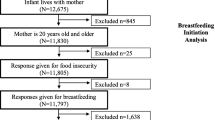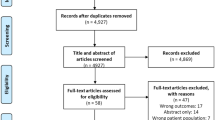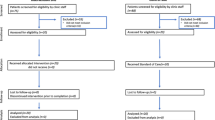Abstract
Objective This study compared the effects of group to individual prenatal care in late pregnancy and early postpartum on (1) women’s food security and (2) psychosocial outcomes among food-insecure women. Methods and Results We recruited 248 racially diverse, low-income, pregnant women receiving CenteringPregnancy™ group prenatal care (N = 124) or individual prenatal care (N = 124) to complete surveys in early pregnancy, late pregnancy, and early postpartum, with 84 % completing three surveys. Twenty-six percent of group and 31 % of individual care participants reported food insecurity in early pregnancy (p = 0.493). In multiple logistic regression models, women choosing group versus individual care were more likely to report food security in late pregnancy (0.85 vs. 0.66 average predicted probability, p < 0.001) and postpartum (0.89 vs. 0.78 average predicted probability, p = 0.049). Among initially food-insecure women, group participants were more likely to become food-secure in late pregnancy (0.67 vs. 0.35 individual care average predicted probability, p < 0.001) and postpartum (0.76 vs. 0.57 individual care average predicted probability, p = 0.052) in intention-to-treat models. Group participants were more likely to change perceptions on affording healthy foods and stretching food resources. Group compared to individual care participants with early pregnancy food insecurity demonstrated higher maternal-infant attachment scale scores (89.8 vs. 86.2 points for individual care, p = 0.032). Conclusions Group prenatal care provides health education and the opportunity for women to share experiences and knowledge, which may improve food security through increasing confidence and skills in managing household food resources. Health sector interventions can complement food assistance programs in addressing food insecurity during pregnancy.
Similar content being viewed by others
References
Abusabha, R., Peacock, J., & Achterberg, C. (1999). How to make nutrition education more meaningful through facilitated group discussions. Journal of the American Dietetic Association, 99(1), 72–76.
American Academy of Pediatrics, & American College of Obstetricians and Gynecologists. (2012). Guidelines for perinatal care (7th ed.). Elk Grove Village, IL: American Academy of Pediatrics.
Barkin, J. L., Wisner, K. L., Bromberger, J. T., Beach, S. R., Terry, M. A., & Wisniewski, S. R. (2010). Development of the Barkin index of maternal functioning. Journal of Women’s Health, 19(12), 2239–2246.
Blumberg, S. J., Bialostosky, K., Hamilton, W. L., & Briefel, R. R. (1999). The effectiveness of a short form of the household food security scale. American Journal of Public Health, 89(8), 1231–1234.
Borders, A. E. B., Grobman, W. A., Amsden, L. B., & Holl, J. L. (2007). Chronic stress and low birth weight neonates in a low-income population of women. Obstetrics and Gynecology, 109(2), 331–338.
Braveman, P., Marchi, K., Egerter, S., Kim, S., Metzler, M., Stancil, T., & Libet, M. (2010). Poverty, near-poverty, and hardship around the time of pregnancy. Maternal and Child Health Journal, 14(1), 20–35. doi:10.1007/s10995-008-0427-0.
Bronte-Tinkew, J., Zaslow, M., Capps, R., Horowitz, A., & McNamara, M. (2007). Food insecurity works through depression, parenting, and infant feeding to influence overweight and health in toddlers. Journal of Nutrition, 137(9), 2160–2165.
Carmichael, S. L., Yang, W., Herring, A., Abrams, B., & Shaw, G. M. (2007). Maternal food insecurity is associated with increased risk of certain birth defects. Journal of Nutrition, 137(9), 2087–2092.
Cohen, S., & Williamson, G. (1988). Perceived stress in a probability sample of the United States. In S. Spacapan & S. Oskamp (Eds.), The social psychology of health: Claremont symposium on applied social psychology (pp. 31–67). Newbury Park, CA: Sage.
Coleman-Jensen, A., Gregory, C., & Singh, A. (2014). Household food security in the United States in 2013: U.S. Department of Agriculture Economic Research Service.
Condon, J. T., & Corkindale, C. J. (1998). The assessment of parent-to-infant attachment: Development of a self-report questionnaire instrument. Journal of Reproductive and Infant Psychology, 16(1), 57–76.
Coyl, D. D., Roggman, L. A., & Newland, L. A. (2002). Stress, maternal depression, and negative mother–infant interactions in relation to infant attachment. Infant Mental Health Journal, 23(1–2), 145–163. doi:10.1002/imhj.10009.
Economic Research Service. (2012). Six-item short form food security survey module. Retrieved from http://www.ers.usda.gov/topics/food-nutrition-assistance/food-security-in-the-us/survey-tools.aspx.
Fowles, E. R., Bryant, M., Kim, S., Walker, L. O., Ruiz, R. J., Timmerman, G. M., & Brown, A. (2011). Predictors of dietary quality in low-income pregnant women: A path analysis. Nursing Research, 60(5), 286.
Fowles, E. R., Hendricks, J. A., & Walker, L. O. (2005). Identifying healthy eating strategies in low-income pregnant women: Applying a positive deviance model. Health Care for Women International, 26(9), 807–820.
Frith, A. L., Naved, R. T., Persson, L. A., Rasmussen, K. M., & Frongillo, E. A. (2012). Early participation in a prenatal food supplementation program ameliorates the negative association of food insecurity with quality of maternal-infant interaction. The Journal of nutrition, 142(6), 1095–1101.
Girard, A. W., & Olude, O. (2012). Nutrition education and counselling provided during pregnancy: Effects on maternal, neonatal and child health outcomes. Paediatric and Perinatal Epidemiology, 26(s1), 191–204.
Hamilton, J. G., & Lobel, M. (2008). Types, patterns, and predictors of coping with stress during pregnancy: Examination of the revised prenatal coping inventory in a diverse sample. Journal of Psychosomatic Obstetrics and Gynaecology, 29(2), 97–104. doi:10.1080/01674820701690624.
Heberlein, E. C., Picklesimer, A. H., Billings, D. L., Covington-Kolb, S., Farber, N., & Frongillo, E. A. (2015). The comparative effects of group prenatal care on psychosocial outcomes. Archives of Women’s Mental Health, 1–11. doi:10.1007/s00737-015-0564-6.
Ickovics, J. R., Kershaw, T. S., Westdahl, C., Magriples, U., Massey, Z., Reynolds, H., & Rising, S. S. (2007). Group prenatal care and perinatal outcomes: A randomized controlled trial. Obstetrics and Gynecology, 110(2), 330–339.
Ickovics, J. R., Reed, E., Magriples, U., Westdahl, C., Schindler Rising, S., & Kershaw, T. S. (2011). Effects of group prenatal care on psychosocial risk in pregnancy: Results from a randomised controlled trial. Psychology & Health, 26(2), 235–250. doi:10.1080/08870446.2011.531577.
Laraia, B. A., Siega-Riz, A. M., Gundersen, C., & Dole, N. (2006). Psychosocial factors and socioeconomic indicators are associated with household food insecurity among pregnant women. Journal of Nutrition, 136(1), 177–182.
Lobel, M. (1996). The revised prenatal distress questionnaire (NUPDQ). Stony Brook, NY: Stony Brook University.
Long, J. S., & Freese, J. (2014). Regression models for categorial dependent variables using Stata. College Station, TX: Stata Press.
Martin, J. A., Hamilton, B. E., Sutton, P. D., Ventura, S. J., Mathews, T. J., Kirmeyer, S., & Osterman, M. J. K. (2010). Births: Final data for 2007. National Vital Statistics Reports, 58(24), 1–125.
Picklesimer, A. H., Billings, D., Hale, N., Blackhurst, D., & Covington-Kolb, S. (2012). The effect of CenteringPregnancy group prenatal care on preterm birth in a low-income population. American Journal of Obstetrics and Gynecology, 206(5), 415.e411–415.e417. doi:10.1016/j.ajog.2012.01.040.
Radloff, L. S. (1977). The CES-D scale. Applied Psychological Measurement, 1(3), 385–401.
Rising, S. S., Kennedy, H. P., & Klima, C. S. (2004). Redesigning prenatal care through CenteringPregnancy. Journal of Midwifery & Women’s Health, 49(5), 398–404.
Scheier, M. F., Carver, C. S., & Bridges, M. W. (1994). Distinguishing optimism from neuroticism (and trait anxiety, self-mastery, and self-esteem): A reevaluation of the life orientation test. Journal of Personality and Social Psychology, 67(6), 1063–1078. doi:10.1037/0022-3514.67.6.1063.
Stotland, N., Tsoh, J. Y., & Gerbert, B. (2012). Prenatal weight gain: Who is counseled? Journal of Women’s Health, 21(6), 695–701.
Stotland, N. E., Gilbert, P., Bogetz, A., Harper, C. C., Abrams, B., & Gerbert, B. (2010). Preventing excessive weight gain in pregnancy: How do prenatal care providers approach counseling? Journal of Women’s Health, 19(4), 807–814.
US Department of Agriculture. (2014). Food security in the US. From http://www.ers.usda.gov/topics/food-nutrition-assistance/food-security-in-the-us/measurement.aspx#survey.
United States Public Health Service. (1989). Caring for our future: The content of prenatal care. A report of the public health service expert panel on the content of prenatal care. Washington, DC: Department of Health and Human Service.
Walker, J. L., Holben, D. H., Kropf, M. L., Holcomb, J. P, Jr, & Anderson, H. (2007). Household food insecurity is inversely associated with social capital and health in females from special supplemental nutrition program for women, infants, and children households in Appalachian Ohio. Journal of the American Dietetic Association, 107(11), 1989–1993.
Watson, D., Clark, L. A., & Tellegen, A. (1988). Development and validation of brief measures of positive and negative affect: The PANAS scales. Journal of Personality and Social Psychology, 54(6), 1063–1070.
Webster, J., Linnane, J. W. J., Dibley, L. M., Hinson, J. K., Starrenburg, S. E., & Roberts, J. A. (2000). Measuring social support in pregnancy: Can it be simple and meaningful? Birth, 27(2), 97–101.
Whitaker, R. C., Phillips, S. M., & Orzol, S. M. (2006). Food insecurity and the risks of depression and anxiety in mothers and behavior problems in their preschool-aged children. Pediatrics, 118(3), e859–e868.
Zaslow, M., Bronte-Tinkew, J., Capps, R., Horowitz, A., Moore, K., & Weinstein, D. (2009). Food security during infancy: Implications for attachment and mental proficiency in toddlerhood. Maternal and Child Health Journal, 13(1), 66–80. doi:10.1007/s10995-008-0329-1.
Acknowledgments
This project was supported the Research, Innovation, and Development Grants in Economics (RIDGE) Center for Targeted Studies, Southern Rural Development Center (SRDC), Mississippi State University, Dissertation Grant Program and by the Agency for Healthcare Research and Quality (Grant R36HS021975).This project also received support from the Institute for Advancement of Healthcare, Greenville Health System. The content is solely the responsibility of the authors and does not necessarily represent the official views of the funders.
Author information
Authors and Affiliations
Corresponding author
Ethics declarations
Conflict of interest
The authors declare that they have no conflict of interest.
Ethical Standard
This study was concurrently approved by the Institutional Review Boards at the Greenville Health System and the University of South Carolina. All study participants provided written informed consent prior to their enrollment in the study.
Rights and permissions
About this article
Cite this article
Heberlein, E.C., Frongillo, E.A., Picklesimer, A.H. et al. Effects of Group Prenatal Care on Food Insecurity during Late Pregnancy and Early Postpartum. Matern Child Health J 20, 1014–1024 (2016). https://doi.org/10.1007/s10995-015-1886-8
Published:
Issue Date:
DOI: https://doi.org/10.1007/s10995-015-1886-8




